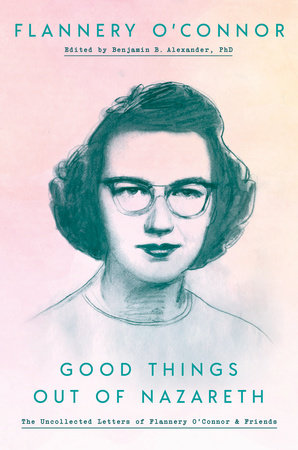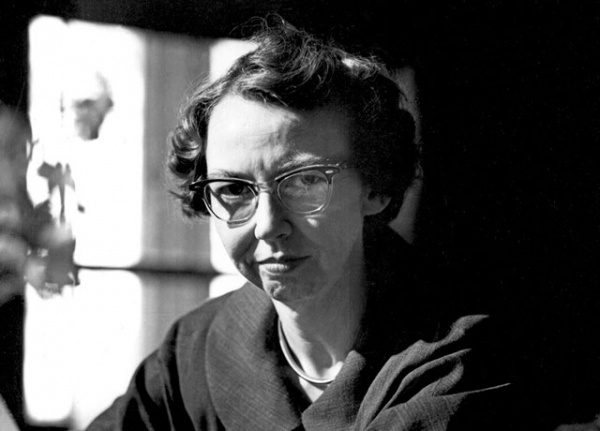Book Review: Writer Flannery O’Connor — The Most Un-Hip Woman Imaginable, and Proud of It.
By Con Chapman
If this collection has one failing, it is its attempt to make Flannery O’Connor into something she was not: “woke.”
Good Things Out of Nazareth: The Uncollected Letters of Flannery O’Connor and Friends, edited by Benjamin Alexander. Convergent Books, 416 pages, $26.
 If ever there were an unlikely object of veneration for the type of aesthete who wears his or her literary heart on their hipster clothing, it is Flannery O’Connor, author of some of the greatest American short stories of the 20th century, and some of the grimmest. She was a devout Catholic who took the Church’s teachings seriously; she viewed the little white wafers distributed during the sacrament of Holy Communion to be the actual body of Jesus Christ and not just a token remembrance of the Last Supper. “If it’s a symbol,” she said with a shaking voice to fellow Catholic writer Mary McCarthy when challenged to defend the Church’s teaching on the subject, “to hell with it.”
If ever there were an unlikely object of veneration for the type of aesthete who wears his or her literary heart on their hipster clothing, it is Flannery O’Connor, author of some of the greatest American short stories of the 20th century, and some of the grimmest. She was a devout Catholic who took the Church’s teachings seriously; she viewed the little white wafers distributed during the sacrament of Holy Communion to be the actual body of Jesus Christ and not just a token remembrance of the Last Supper. “If it’s a symbol,” she said with a shaking voice to fellow Catholic writer Mary McCarthy when challenged to defend the Church’s teaching on the subject, “to hell with it.”
Yet today’s O’Connor enthusiasts can buy T-shirts and buttons with quotes taken from her writings or march in an annual parade in her honor, which boasts a strolling band of eccentric young musical admirers, in her birthplace of Savannah, Georgia. Rocker Bruce Springsteen told The New York Times Book Review in 2014 that O’Connor was his biggest influence. But her stories have none of the misplaced pity that is the essence of po’ boy rock and roll played by musicians in torn denim who fly in private jets. All of this idolization would have galled O’Connor no end.
The contrast between the woman who wrote the stories and the cult she has inspired is brought into stark relief by a new collection of her letters. This is the second volume of her correspondence to appear in print; the first, The Habit of Being, ran to 550 pages and kept right on going. (Back in the mid-20th century, serious writers and those who aspired to that status kept carbon copies of their correspondence.) Good Things Out of Nazareth assembles letters that were donated to Duke University by Thomas Gossett, an academic friend of O’Connor’s. The volume is 200 pages shorter than The Habit of Being and offers a helpful introduction to O’Connor’s mind.
O’Connor was a Catholic in the South, which (except for islands of Romanism such as New Orleans and Baltimore) has been accurately described as the Bible Belt. A survey of the small town I grew up in currently shows 72 churches (there is one synagogue): only two of them are Catholic, the rest are Protestant, a few high-class (one Episcopalian) but mostly low (Baptist). Despite her faith’s minority status in the South, she was a writer trying to create literature from the Catholic tradition she was raised in. Ironically, there is no faith more vigilant in protecting its adherents from the temptations of art. At the age of 31, with an O. Henry Award for the best short story of 1956 to her credit, she was still sufficiently cowed by the authority of the church to ask permission to read André Gide, whose works were listed on the Catholic Index of Forbidden Books.
She was thus an outsider from the get-go, as they say down South, but when she left the region to pursue her career, she found she was also a misfit in the literary/academic circles she moved in. When she first arrived at the University of Iowa’s Creative Writing Program her Georgia accent was so thick her advisor had her repeat what she’d said three times. He then gave up and asked her to write her responses down on paper. She would lose the accent, but would retain in large part a worldview that would have shocked the prevailing literary conscience of the times. From Good Things Out of Nazareth we learn that in 1949 O’Connor supported the demand by poet Robert Lowell that the director of the Yaddo artists’ colony be dismissed for colluding with a Soviet agent. To a liberal ear (then and now), this smacks of McCarthyism. But it was consistent with her view that there was a difference between a Russian artist and a Soviet Communist; Communists were enemies of her faith who forced closures of churches and imprisoned priests. She believed in good and evil, and didn’t hesitate to scorn the latter when she encountered it, prevailing cultural opinion to the contrary be damned.
O’Connor would thus never lose the sense that, in the words of the old Southern spiritual, she was “a pilgrim and a stranger” wherever she went, and it is perhaps this inability to find comfort in the here and now that fueled her motor, which could accelerate from an innocent idle speed to a head-on collision in the space of a short story. She was not content with the little epiphanies of the sort that characterized what came to be known as “The New Yorker short story.” That magazine put its money on another writer of Irish descent — John O’Hara — whose stock-in-trade was dramatizing the personal slights and status insecurity of the East Coast striving class. In O’Hara’s lifetime The New Yorker published 247 of his short stories — still a record — and none of O’Connor’s. If there is a body of opinion today that ranks O’Hara higher than O’Connor, I haven’t encountered it.

Flannery O’Connor — She was neither a conservative nor a liberal, proving that political assessments aren’t very useful in judging literature. Photo: Georgia Humanities.
Except for her years in Iowa and brief stays in the Northeast, she lived at home with her mother on a dairy farm in Milledgeville, Georgia, due in large part to lupus, the disease that both she and her father died from, which kept her on crutches towards the end of her life. It is this aspect of her background that may have prevented her from condescending to her fictional characters. She jokingly lapses into Southern vernacular throughout the current collection, proclaiming herself “real pleased” and “mighty proud” to be asked to serve on a committee that churned out supposedly non-partisan criticism of President Eisenhower. Amusingly, she acknowledges the contributions of a farm hand’s wife to her store of rural dialect.
If this collection has one failing, it is its attempt to make O’Connor into something she was not: “woke.” It is the last thing she would have called herself if she’d lived long enough to hear the term in its current usage, but which the editor says was her effect on him when he first encountered her work in the late ’60s. Two of her stories (“The Barber” and “The Crop”) mock left-wing characters; the former recounts a haircut endured by a liberal in a barber shop filled with rednecks, the latter the strenuous efforts by a maiden lady writer, politically correct avant la lettre, to produce a story about the South without offending anyone. It was an effort O’Connor refused to make; she could only laugh at those who did, and we are the beneficiaries of her choice in the matter.
She also took an unsparing view of the Babbitts of the world, expressing dismay at the possibility that Ronald Reagan would play a role in the dramatization of her story “The Life You Save May Be Your Own,” which she sold to a television show he hosted. On the other hand, she admired her parents’ business savvy, and parted ideological company with Catholic Marxists such as Dorothy Day over their reflexive antipathy towards the charity of plutocrats such as John D. Rockefeller. She belonged to no school of writers; she was both a Catholic and a harsh critic of most self-consciously pious fiction.
O’Connor’s works should be a cautionary tale for those who would downgrade art because of the unfashionable views and lives of their creators. She saw — or imagined she saw — the effects of grace in the lives of the Southerners around her. She was neither a conservative nor a liberal, proving that political assessments aren’t very useful in judging literature. She was a cafeteria-style connoisseur of ideas who tried to reflect accurately, though through a Christian prism, the world around her. She was the most un-hip woman imaginable, and proud of it. She never married, remained a virgin all her life, and attended Mass daily.
Maybe there’s a market for instruction in that lifestyle at some low-residency M.F.A. program.
Con Chapman is the author of Rabbit’s Blues: The Life and Music of Johnny Hodges (Oxford University Press).

Oh my. Words have fled my brain. One of the most brilliant portraits of O’Connor – in which it also enlightened me with many facts about which I had no idea of their previous existence. I think I had been raised mostly on a writer’s words and not on the background which had cultivated those words.
Partly, I spent a good deal of time in Montreal. But before Montreal,there was Utah, those were my Steinbeck days. Savannah is a gem. Not that many years ago in our house in Middlesex County, MA I had found a CPUSA card that had belonged to my father, which verified what I had suspected. I thought it best to burn it with a match and to then toss it into a wet sink. And I did just that. Especially since I had been told growing up that the FBI had shown up at our door step one day when my step brother and I were in school. My father’s second wife was an M.D. from Poland, who’d come to Utah on a post-doctoral (Ph.D. Pharmacology) fellowship to work specifically with my father, who’d recently been divorced. Hormones took over. We live in a many-storied country. Not all stories are sweet or innocent. Some hearken back to WWII horrors, and some to the instability of life, madness and disease. Now I have to see if I have this book on my Kindle for PC .
Your essay says, “She remained a virgin all her life.” Maybe so, but I have never read this before as a fact. What is your source for that?
Algis Valiunas in a review of Brad Gooch’s biography of O’Connor in the March 9, 2009 American Spectator describes her in the words of a tombstone limerick: “born a virgin, died a virgin, no hits, no runs, no errors.” Of course, the fact cannot be definitively established, but she was a devout Catholic, lived much of her life at home with her mother, went to an all-female college, and is never reported to my knowledge to have dated or had a boyfriend much less a lover. The first factor is the most important, I think; back in the day, devout Catholic girls didn’t have sex before marriage.